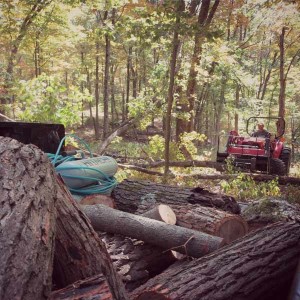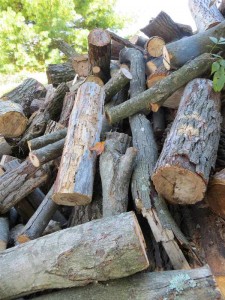When we bought the farm, our first home improvement project was to replace the fuel oil heater with a new main source of heat.
The fuel oil heater may have made sense when it was installed in 1990, but since then fuel oil prices have quadrupled. I also hated how dirty it burned, leaving a grimy layer of black soot on my vents. The farmer hated the fact that it needed electricity to operate. He worried we’d be caught cold and out of luck in a winter storm.
Wood heat is more energy efficient and produces less pollution than fossil fuel heat sources. Some wood pellet stoves require electricity to run, but most wood stoves do not. A wood stove with a cook top could come in handy during winter emergencies. Since we have access to trees and wood-cutting equipment, heating our home with wood could save us money.
We prepped the chimney and installed the new woodstove as the fall colors peaked, which left too little time to cut firewood. I called the first firewood ad in the classifieds, which led to my first mistake.
Mistake #1: Taking suppliers word for it
I ordered two cords of firewood. The supplier delivered a heaping trailer of firewood. I handed him cash and waved goodbye before I stacking.
One cord is 128 cubic feet. That is a neatly stacked pile of firewood that is 8 feet long, 4 feet wide and 4 feet tall. When I measured the stacked firewood I discovered the supplier had cut me short. I left a polite voicemail message that he never returned. I noted my error and pledged to stack and measure my firewood before dismissing the supplier next time.
Mistake #2: Not all wood is created equal
I found a different supplier and ordered two additional cords. This time I requested a receipt that had his name, address, date, quantity and price for the amount of firewood delivered. Unlike supplier #1, supplier #2 helped me stack. I was pleasantly surprised to find he topped off with a little extra firewood! Unfortunately I burned through #2’s mostly light-weight firewood twice as fast.
A mix of hardwoods is ideal firewood. White ash, oak and hickory are a few fine heavy woods in my ‘neck of the woods.’ The heavier wood is, the more heat it produces per volume. Elm, cherry and red maple are acceptable mid-weight woods. Soft woods like pine and spruce create sparks and leave residue in the chimney. Light-weight woods like aspen and poplar burn faster and put off less heat. They are okay for kindling, but not efficient for firewood. Remember, high moisture content makes wood feel heavier.
Even if I had inspected the wood at the time of delivery, back then I did not have the knowledge or ability to identify what type of wood it was. I learned my lesson, bought a tree ID guide and educated myself on familiar species in my region. If you don’t take to book learning, consider attending an educational day in the woods program at a nearby state park where you can learn to identify trees from an expert.
Mistake #3: Not all wood stoves are created equal
The United States Environmental Protection Agency (EPA) rates wood heaters on standards of emissions, efficiency and heat output. A list containing the data is available online. The list is organized by manufacturer, model and type of appliance. I looked over the EPA’s list, assuming stoves with similar ratings were equal in every way but price, and chose one that fit my space and budget requirements.
A stove’s efficiency is affected by several variables the EPA does not take into consideration, such as location of stove and chimney. My chimney is located in the far corner of my house. The majority of the heat it produces stays in the living room. As a result, I moved my bedroom downstairs and accomplish the majority of my winter activities in the living room to be close to the heat. Adding a blower helped distribute the heat and recover some heat loss, but choosing a better suited stove for my set up would have avoided the extra cost and effort.
Related story: Firewood basics: Tips for drying, storage and safety















We bought a Blaze King fireplace insert a few years ago but my husband spent about 2 months (evenings) researching them. What he liked best about it was, at the time, the only one with a thermostat & the catalytic converter, which turns the smoke and fumes into heat also so that we more out of our wood. On an average winter day here in NE Kansas 3 pieces of wood will last all day. We totally love it!
There’s nothing more helpful than advice from someone who’s been there – done that. Here’s a table of firewood heat and weight values your readers might find helpful.
http://bit.ly/1xnfLAw